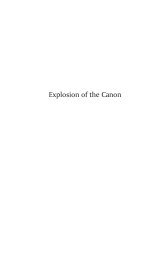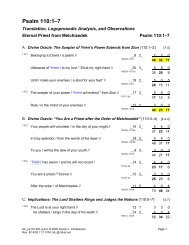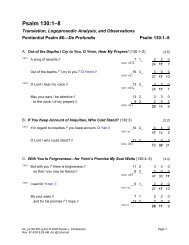Reading Genesis 1-2 in Hebrew - Bibal.Net
Reading Genesis 1-2 in Hebrew - Bibal.Net
Reading Genesis 1-2 in Hebrew - Bibal.Net
Create successful ePaper yourself
Turn your PDF publications into a flip-book with our unique Google optimized e-Paper software.
<strong>Read<strong>in</strong>g</strong> <strong>Genesis</strong> 1–2 <strong>in</strong> <strong>Hebrew</strong><br />
�����Œ�������������„<br />
������û��������������������œ•���1:6�<br />
��������������„ �����û������������������������<br />
�����Œ�������������„<br />
������û��������������������œ•��—transliteration:<br />
way-yOµ'-mer 'È-lO-hÓµm y¸-hÓµ rA-qÓµ-av<br />
B¸-tÙµk ham-mAµ-yim, “and Elohim said, ‘Let there be a firmament <strong>in</strong> the midst of the waters.” The<br />
verb here is Qal perfect 3 rd sg. masc with wau-conversive from the root rm' (“say”) with £yih»lÈ'<br />
(“Elohim”) as subject. The verb yihÃy is Qal imperfect 3 rd sg. masc from the root hyh (“be[come]”)<br />
used as a jussive. The masc. noun avyiqAr (“extended surface, firmament”) has no real equivalent<br />
<strong>in</strong> current English. It refers to the “vault of heaven” <strong>in</strong> the cosmology of the ancient Near East<br />
and was apparently seen as solid, and support<strong>in</strong>g the “waters” above it. The old word<br />
“firmament” is as good as any. Another possibility is “sky dome.” On the furtive Paµtax <strong>in</strong> avyiqAr,<br />
see the discussion of ax˚r <strong>in</strong> 1:2 above. The preposition Ùt–⁄b (“<strong>in</strong> the midst of”) is a comb<strong>in</strong>ation<br />
of the preposition –b (“<strong>in</strong>”) and the substantive ∆wKAtµ (“midst”). The “waters” (£«y–Amµ ah) were<br />
envisioned to be above the firmament, on the earth, and also beneath the earth.<br />
�������������„ �����û��������������������—transliteration:<br />
wÓ-hÓµ mab-DÓµl B µn maµ-yim lA-mAµ-yim, “and let it<br />
divide between the waters and the waters.” When the wau-conjunction is prefixed to the verb yihÃy<br />
the sequence of two successive occurrences of shewa becomes a long vowel Ó. The verbal form<br />
lyi–d�bam is the Hiphil (causative) sg. masc. participle from the root ldb (“be divided, separate”).<br />
The preposition §y–Eb (“between”) is used here together with the preposition l (“to”) to express the<br />
idea of between the waters here and the waters there. Note the lengthen<strong>in</strong>g of both the first and<br />
second vowels <strong>in</strong> the word £«yΩflmAl. Before words stressed on the first syllable, the preposition l is<br />
optionally vocalized with A. The lengthen<strong>in</strong>g of the second vowel is because the word is <strong>in</strong><br />
pause (i.e., the last word <strong>in</strong> the sentence).<br />
��˜����������‘������������������•œ•���1:7�<br />
����������������������������������Œ�����‹<br />
���������•œ•�����<br />
�����‘������•���������������������„<br />
����������Œ�������������<br />
˜���������‘������������������•œ•��—transliteration:<br />
way-yaµ-vaW 'È-lO-hÓµm 'et-hA-rA-qÓµ-av, “and Elohim made<br />
the firmament.” The letter W is to be dist<strong>in</strong>guished from H. The verb WavC¬yaw is Qal imperfect 3 rd sg.<br />
masc. with wau-conversive from the root hWv (“make, do”) with £yih»lÈ' (“Elohim”) as subject.<br />
The def<strong>in</strong>ite direct object marker -te' is connected to the masc. noun avyiqAr (“firmament”) by<br />
maqqEp. The s¸gÙlt‰ ( Ç ), which is located above the v at the end of the word aÇvyiqArAh, is one of<br />
the stronger disjunctive accents and appears only when the verse has three sections.<br />
����������������������������������Œ�����‹<br />
����������•œ•�—transliteration:<br />
way-yab-DEµl B µn ham-maµ-yim '·-Heµr<br />
miT-Taµ-xat lA-rA-qÓµ-av, “and he separated between the waters that were under the firmament.”<br />
The verb is Hiphil (causative) imperfect, 3 rd sg. masc. from the root ldb (“be divided,<br />
separate”). The construction §yEb˚ ... §y–Eb (“between” … “and between”) designates space<br />
© 2005 BIBAL Corporation, All Rights Reserved Version 1.0<br />
6





